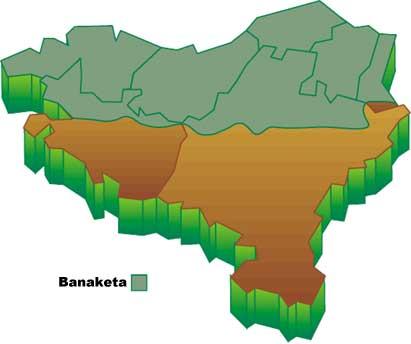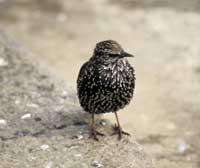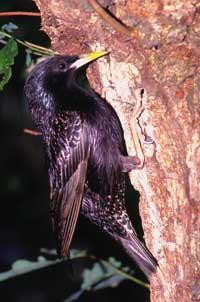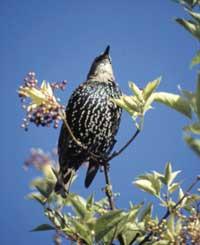Estornino pinto, winter invader in the fields

Dusk in the lagoon of Pitillas. The weather is turbulent and the last rays of the sun have colored the dark clouds with purple. At a distance, an almost black cloud seems to be moving alive. Gradually we get closer and with the palate, instead of the cloud, we realize that it is a huge balance of birds. There are thousands of birds flying together, moving in the style of waves up and down or turbulence in perfect synchrony. They have started planning in front of the reed and, as someone had commanded, they have all come down together to the protection of the vegetation.

Arabazo pepper balances can be seen throughout the Basque Country during the winter season, but in addition to these wintering, we also have some of those that are nesting. In fact, about 30 years ago the first breeding of this species was verified in our territory and since then has been continuously spreading from north to south. Thus, although in small quantities, it has now filled the entire Cantabrian slope. If we go to the Mediterranean area we will see more starlings, but of another species, the black arabazos. This second species has spread in a few years surprisingly in the south of our country, and its distribution is complementary to the granular. To see if we can not mix the pinto starling with similar species.
Blackbird has some similarity to the arabazo, but they can be easily distinguished, especially because blackbird is a little larger and has a longer tail, and while walking the Arabic makes it on foot. The distinction between pinto (Sturnus vulgaris) and black (Sturnus unicolor) is not that easy. Both are the same size: 21,5 cm in length and 75-90 grams in weight. The plumage is similar.
They are very dark, almost black, decorated with irises and blue, green and striking purple reflections. In winter clothing it is easy to distinguish both species, since clumps (especially females) have white pints throughout the body and black much less. In zeal, on the contrary, the rogue has few white scars, so it resembles black more.

As for their nature, granular starlings are gregarious throughout the year, but these spectacular balances of thousands of units are usually seen only in winter. This bird, on the other hand, is an eccentric singer. It has capacity to emit many different sounds and likes to imitate songs of other species. These curious hobbies have to do with reproduction, it seems that males from a wide range of sounds have more chances to find a partner.
A fast bird that has been able to take advantage of the human being and that has managed to extend it to all corners: fields of cultivation, trees, rural areas, rural parks, etc. The decline of forests and the proliferation of fields and fields of grass have favoured the arabazo. Another reason for this bird's success is its ease of using different types of food.
Exploring fields and fields of grass, these omnivorous animals chain insects, seeds, fruits, etc. These large winter camps look for remains of vineyards, olive trees and, in general, leftover crops. Their association in such large groups allows them to carry out an appreciable work in the control of the bugs, but for the same reason they can produce crop damage.
Spring is a time to reproduce also for the rogue Arabazo, so it will look for a hole to nest. Although in most cases you opt for a hole (and especially the oak), you can choose alternately between a rock cliff, an artificial wooden nest or a hole in some building. Examples of the latter are nests in a house of Jaurrieta or in the church of Kortezubi. Once inside, the female lays about 5 eggs.
It should be noted that the starling female, before putting the eggs in its nest, can put some egg in another nest like the cuckoo. Unlike Kukua, he then pulls out his chitada. In addition to what he can grow, he can give his success by leaving more eggs to a neighbor, producing more offspring. In any case, the incubation of these light blue 30 mm eggs lasts between 11 and 13 days. These chickens that are born without pen and blind grow quickly fed by invertebrates so rich in protein. In fact, the first 12 days pass from 5 grams to 60 grams and are already able to fly at 18-22 days.

At this age its coloring is quite different from that of adults: the brown plumage without discs and a lighter coloring in the paparo. Despite leaving the nest, parents will travel the first few days around the pups to feed and help advance. In most cases, parents try to get a second chitazo.
As partial migrants, autumn coincides with the migration to the south of Northern European Arabs. The pass balances of this bird are usually special, since the birds are usually very tight. The cantilever is also curious, as they do it straight and with strong flaps, at an average speed of 34 km/h. Hunters have long known the customs and movements of this bird, and proof of this are the different names it receives in Basque: tordantxa, zozabarra, artxoxua, etc.
As for the distribution of this bird, we can find it in almost all of Europe and, as has already been said, in recent years the populations have grown in extension to the west. The human being has also taken him to other places and is a good example of the success of this animal. In 1890 and 91 between 120 and 160 referees from Europe were released in New York. By 1950 it spread throughout the United States and the population was estimated at around one million copies.
Species: Sturnus vulgaris Family: sturnids Order: passerines Class: birds |
Buletina
Bidali zure helbide elektronikoa eta jaso asteroko buletina zure sarrera-ontzian











